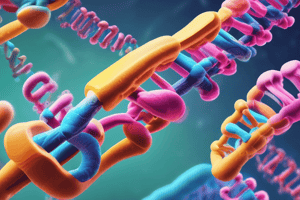Podcast
Questions and Answers
Where are chromosomes usually found inside a human cell?
Where are chromosomes usually found inside a human cell?
- Nucleus (correct)
- Endoplasmic Reticulum
- Mitochondria
- Ribosomes
What do chromosomes determine in humans?
What do chromosomes determine in humans?
- Liver function
- Heart rate
- Cholesterol level
- Hair color (correct)
Which component contains DNA in a human cell?
Which component contains DNA in a human cell?
- Mitochondrion
- Nucleus (correct)
- Ribosome
- Lysosome
What is the primary function of RNA in a cell?
What is the primary function of RNA in a cell?
When do chromosomes become visible in a cell?
When do chromosomes become visible in a cell?
Which of the following cell types do not contain chromosomes?
Which of the following cell types do not contain chromosomes?
What is the main difference between the female gamete (ovum) and the male gamete (sperm cell)?
What is the main difference between the female gamete (ovum) and the male gamete (sperm cell)?
What is the outcome of the fusion of male and female gametes?
What is the outcome of the fusion of male and female gametes?
What is the definition of a phenotype?
What is the definition of a phenotype?
What term describes the transmission of genes from one generation to the next?
What term describes the transmission of genes from one generation to the next?
Which process describes the survival of the fittest and passing down desirable characteristics?
Which process describes the survival of the fittest and passing down desirable characteristics?
What term best defines 'variation' in a population?
What term best defines 'variation' in a population?
Flashcards are hidden until you start studying
Study Notes
Gametes
- A sperm cell is motile, meaning it can move, and has 23 chromosomes, which is one set of chromosomes (haploid).
- The female gamete, ovum, is stationary (non-motile) and also has 23 chromosomes, which is one set of chromosomes (haploid).
- The fusion of a sperm cell and an ovum results in a zygote, which has 46 chromosomes (two sets).
Zygote and Haploid
- A zygote is the new cell formed when a sperm cell and an ovum combine.
- A haploid is a cell with one set of chromosomes, characteristic of reproductive cells like egg cells and sperm cells.
Diploid and Sex Inheritance
- A diploid is a cell with two sets of chromosomes, which is characteristic of all other cells in the body except gametes.
- Inheritance is the transmission of genes from one generation to the next.
- A genotype is the genetic makeup of an individual, represented by XY or XX, while a phenotype is the physical expression of those genes.
Variation and Natural Selection
- Variation refers to the differences between individuals of the same species.
- Natural selection is the process by which the best adapted animals are able to survive and reproduce, passing on their beneficial traits to their offspring.
- It is often referred to as "the survival of the fittest."
Chromosomes and Cells
- Humans have 46 chromosomes, arranged in 23 pairs, which are only visible during cell division.
- Chromosomes are found in the nucleus of a cell and contain genetic material.
- Autosomes are the chromosomes that determine physical characteristics or traits.
- A cell divides, and chromosomes replicate during this process.
DNA and RNA
- DNA (deoxyribonucleic acid) is found in the nucleus of a cell and contains genetic material.
- DNA has a double helix structure.
- RNA (ribonucleic acid) is involved in protein synthesis and is found in viruses.
- Chromosomes are not visible until just before a cell divides, and they need to be stained to be visible.
Studying That Suits You
Use AI to generate personalized quizzes and flashcards to suit your learning preferences.




